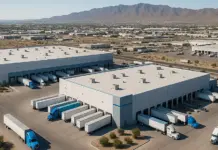In the digital economy of today, supply chain performance is no longer a competitive advantage but a survival tactic. Behind it all lies the reliability and uptime of critical equipment—trucks, conveyors, forklifts, and other equipment that form the logistics backbone. The advent of predictive maintenance, powered by powerful AI algorithms and mass-scale IoT connectivity, is revolutionising the management, maintenance, and optimisation of the lifecycle of such assets for enterprises. Supply chain stakeholders are witnessing the spectacular decline in unplanned downtime, operational costs, and inefficiencies with proper implementation of predictive maintenance, dramatically changing the equipment management landscape.
The Rise of Predictive Maintenance in Modern Supply Chains
Predictive maintenance is an approach that utilises real-time data capture, analytics, and AI-driven modelling to predict equipment failure before it happens. Unlike traditional preventive maintenance, where preventive fixes and replacement of components are required at fixed intervals of time or mean lifecycles, predictive maintenance is accomplished through condition-based monitoring. It allows for interventions on specific wear and tear, deviations, and failures.
This is a robust process that arises primarily because of the convergence of IoT and AI technologies. Truck, conveyor belt, and forklift sensors pump real-time operating data—vibration readings, temperature, condition of the oil, and other performance indicators—to main cloud-based systems. Artificial intelligence-driven algorithms sort through the data, identifying faint patterns and irregularities that are the earliest indications of mechanical distress. This data-driven approach not only increases the working life of the assets but also streamlines maintenance schedules so that interventions take place at the right time and with minimal dislocation.
Quantifiable Benefits: Uptime, Efficiency, and Cost Savings
Supply chain managers are well aware that unexpected equipment breakdown is disastrous, resulting in bottlenecks, late deliveries, and dissatisfied customers. Predictive maintenance addresses these challenges head-on by significantly enhancing equipment availability. The gains are indirectly passed on to increased throughput as well as to environmentally friendly supply chain operations. Predictive maintenance also encourages a lean operating culture and continuous improvement.
Integration of Predictive Maintenance with Supply Chain Technologies
The full value of predictive maintenance is achieved when supplemented best by other digital tools in the supply chain. Predictive maintenance data can be used by TMS and WMS as input to drive deliveries dynamically or schedule operations in real time. Integration to this extent avoids interruptions and keeps supply chains agile and responsive to unexpected events.
Along with this, digital twin usage—computer copies of physical assets—also provides for even more sophisticated predictive maintenance strategies. With virtual simulation of various types of failure and stress testing of equipment, businesses can tailor maintenance schedules to be even more precise and cost-effective.
Workforce Empowerment and Sustainability
Besides operational savings, predictive maintenance also facilitates workforce and sustainability initiatives on a larger level. Properly maintained equipment runs cleaner, consumes less power, and creates fewer greenhouse gas emissions—a very significant factor in today’s green business environment.
On the human front, predictive maintenance gives maintenance professionals state-of-the-art diagnostic capability and real-time notification, more fully empowering them to make quality choices and assign tasks. Not only does this improve job satisfaction but also makes the workplace safer with fewer dangerous emergency overhauls and a lower accident likelihood.
Conclusion
With increasingly complex and uncertain global supply chains depending on digital transformation to navigate complexity and uncertainty, predictive maintenance is the driving force for resilience, productivity, and lasting competitiveness. Through leveraging the ability of AI and IoT to forecast, companies can maintain their trucks, conveyors, forklifts, and other capital equipment at the levels of maximum performance.































